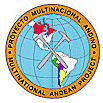
 |
MAP NEWS |
Upcoming ActivitiesVolcanology Short Course - Peru The volcanology short course to be given by Dr. Catherine Hickson (MAP Project Manager) and Dr. Kelly Russell (University of British Columbia Department of Earth and Ocean Sciences) is scheduled for December 6 through 10, 1999 at the INGEMMET offices in Lima. PIMA Training Ms. Anne Thompson of PetraScience Consultants Inc. will be in Peru during the first week of November (2 through 5) to give an introductory course on the use and applications of the PIMA - Portable Infrared Mineral Analylser. Ms. Thomspon will be in Bolivia to give the same course from November 22 to 26. Fluid Inclusion Training Mr. Jim Reynolds of Fluid Inc. in Denver, Colorado will be travelling to Bolivia and then to Peru to setup the MAP donated Fluid Inclusion equipment in both countries and then give introductory courses on the use of the equipment as well. He will be in Bolivia from December 2 through 8 and in Peru from December 13 to 17, 1999. Mr. Mike Villeneuve, head of the GSC Ar/Ar lab in Ottawa, wil be in Santiago, Chile from November 17 through 25 to consult with Chilean scientists setting up a geochronology lab at the SERNAGEOMIN facilities in Santiago. Verifiable Indicators The deadline for submission of Verifiable Indicators to MAP administration was October 30, 1999. To date two of the four MAP countries have submitted them. They can be faxed in or you can fill out the on-line form on the MAP WEB page at pma-map.com/indicators.html Cordilleran Exploration Roundup 2000 and MAP Executive Council Meetings As was the case in 1998, the year-end Executive Council Meetings for MAP will be held in Vancouver at the time of Cordilleran Roundup 2000 (January 25 to 28, 2000). MAP members are invited to participate in their choice of the many events organized for this year's conference, which includes technical meetings, short courses, trade show, social events, and poster displays. MAP will also have a booth displaying project information as well as information provided by the participant's Geological Surveys. It is anticipated that the MAP Executive Council Meetings will be held in the afternoons of 26th, 27th, and 28th of January.
Sample Three countries have sent in preliminary small rock samples and thin sections for evaluation as potential petrological standards. Two of the rock types are unsuitable, due to problems with large phenocryst size, inhomogeneity due to pyroclastic textures such as fiamme, and obvious alteration features. The andesite from Chile is a good example of the type of rock needed for a sample standard, and is consistent with the collecting guidelines defined by the MAP petrological standards program (refer to MAP Petrological Standards Guidelines, updated August 12, 1999, distributed at MAP Executive Council meeting in Santa Cruz). The Chilean andesite contains small (1-2 mm) phenocrysts evenly distributed in a homogeneous, aphanitic to glassy groundmass consisting of microlites of plagioclase and pyroxene and opaque oxides. In order to characterise the rocks as standards, it is necessary to send several hand specimens so the consistency can be evaluated, and also for preliminary geochemical analyses to make sure that the rock type is in the correct range for the standard. It is recommended that each country should choose 3 or 4 different rock sample locations and to send at least 3-4 kg of each to Vancouver for preliminary evaluation, in order to select the samples best suited to becoming standard samples. Congratulations on a good start, keep those potential standards coming in! If you have any questions please contact:
The Andes of western South America are one of the world's great metallogenic provinces, being host to a range of deposit types and ages that is rarely matched elsewhere on Earth. Why is this orogen so metallogenetically rich? What influences the diversity of ore deposit types? What are their geologic controls? How have tectonic events influenced ore genesis? What is the relative role of crust versus mantle during magma and ore genesis? And, what do these deposits teach us about fundamental metallogenetic and ore genesis questions? These are some of the topics that we will examine at a session focused on Andean geology and metallogenesis this coming April. The session is part of the Cordilleran Section of the Geological Society of America annual meeting. The scientific meeting is being held in Vancouver, British Columbia (Canada). Papers are being solicited on topics ranging from the scale of the Andean orogen to site specific studies of particular deposits or types of deposits, or of processes important to ore genesis. Our intention is to present the range of geologic and ore genetic information and research undertaken along the length of the continental margin arc. More information regarding the schedule and logistics of the conference are available at the Geological Society of America web site devoted to the 2000 Cordilleran section meeting (http://www.geosociety.org/profdev/sectdiv/cord/00cdmtg.htm). Abstracts for the meeting are due January 10, 2000 at GSA. Abstract forms can be downloaded as PDF files from the web site and mailed directly to GSA. Conversely, abstracts can be submitted electronically, and that information is available on the web site as well. Please do not hesitate to contact us (information listed below) if you have any questions. Lastly, please send Dick Tosdal a copy of your abstract; DO NOT submit them to him. An electronic copy to him will suffice. For further information please contact: Dick Tosdal, Director, MDRU Andre Panteleyev, XDM Consultants Inc. |